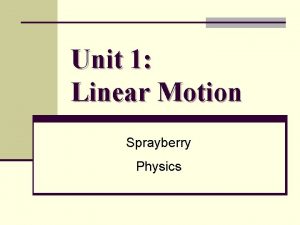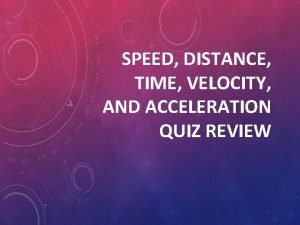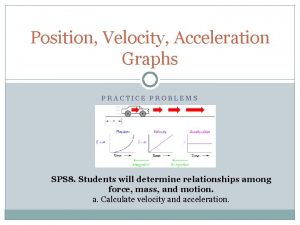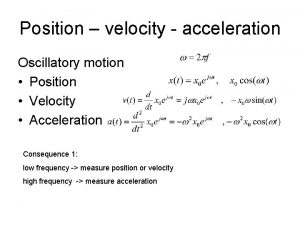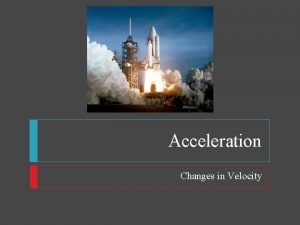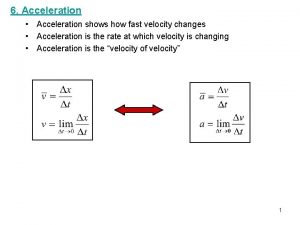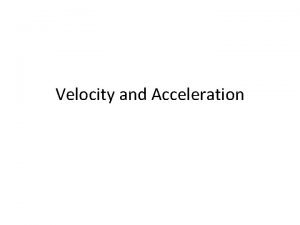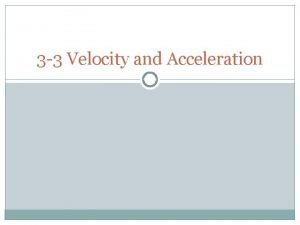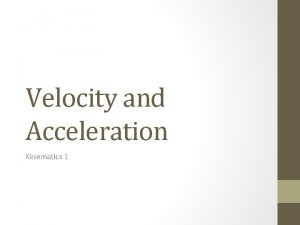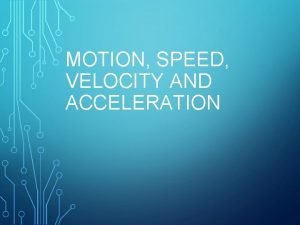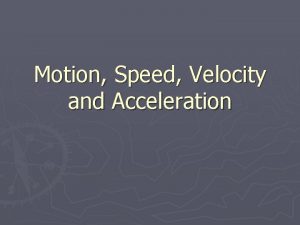Acceleration Measures How Fast Velocity Changes Motion and










- Slides: 10

Acceleration Measures How Fast Velocity Changes Motion and Forces Unit Chapter 1 Section 3

1. Speed and Acceleration Can Change with Time Acceleration

1. Speed and Acceleration Can Change with Time (answers) Describes the change of velocity over time A rate Is a vector Refers to any change in velocity Acceleration Has size and direction No acceleration if no change in velocity

2. Describe each type of Acceleration in the same direction as the motion (positive acceleration) Acceleration in the opposite direction as the motion Acceleration at a right angle to the motion (negative acceleration) (acceleration in direction)

2. Describe each type of Acceleration (answers) Acceleration in the same direction as motion Acceleration in the opposite direction as motion (negative acceleration) Acceleration at a right angle to the motion Speed of the object decreases Direction of the object changes but the speed remains the same (positive acceleration) Speed of the object increases (acceleration in direction)

3. What information is needed to measure acceleration? �The change in velocity �The time it took for the velocity to change

4. What is the formula for acceleration? What units are used for each of the values? �Formula is: • Final velocity – Initial Velocity �Time �Units of measure for each value are: • Final velocity and initial velocity: meters/second • Time: seconds • Acceleration: meters/second 2, which means (meters/second)

5. A skater begins skating at 1 m/s. After 4 seconds, her velocity is 3 m/s. What is the skater’s acceleration? Show your work. �Formula is: • Final velocity – Initial Velocity �Time � 3 m/s – 1 m/s 4 s � 2 m/s /4 s = 0. 5 m/s/s or 0. 5 m/s 2

6. A car has an acceleration of 4 m/s 2. What will the increase in its velocity be after 2 seconds? If it started with a velocity of 30 m/s, what is it’s final velocity? �Acceleration is 4 m/s 2, which means it increased it’s velocity 4 m/s every second. �After 2 seconds, it would be 4 m/s x 2 seconds = 8 m/s 2. �It’s initial velocity was 30 m/s. �It increased it’s velocity by 8 m/s in 2 seconds so it’s final velocity is: � 30 m/s + 8 m/s = 38 m/s

7. Fill in the velocity – time graph below to show the velocity of a ball rolling at a constant speed of 7 m/s for 5 seconds. Velocity (meters/second) 8 7 6 5 4 Velocity (meters/second 3 2 1 0 0 1 2 3 Time (seconds) 4 5
 Final velocity initial velocity acceleration time
Final velocity initial velocity acceleration time Constant acceleration speed time graph
Constant acceleration speed time graph Linear quantities
Linear quantities Angular acceleration and linear acceleration
Angular acceleration and linear acceleration Tangential acceleration and centripetal acceleration
Tangential acceleration and centripetal acceleration What is the difference between velocity and acceleration
What is the difference between velocity and acceleration Velocity
Velocity Speed, velocity and acceleration quiz
Speed, velocity and acceleration quiz Speed, velocity and acceleration problems
Speed, velocity and acceleration problems What is relative acceleration
What is relative acceleration Positive velocity and negative acceleration graph
Positive velocity and negative acceleration graph





